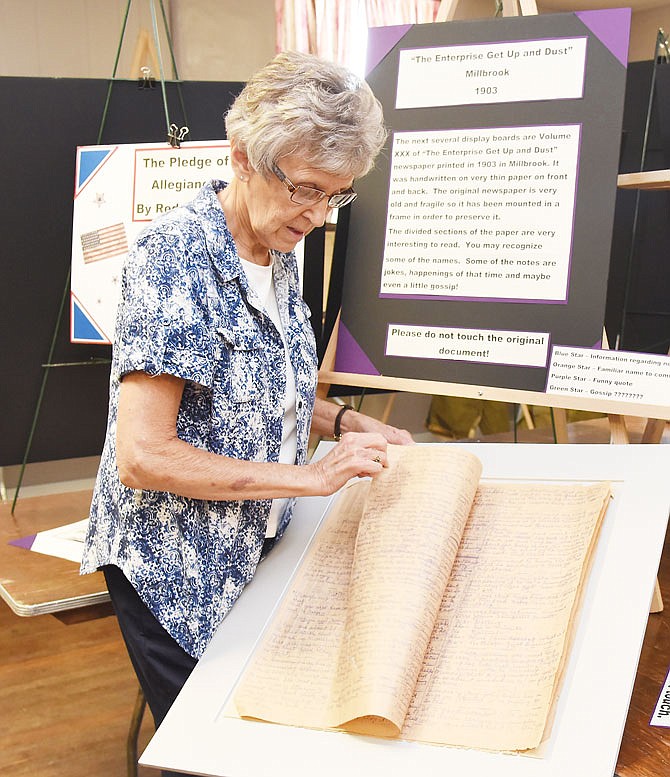A small group of about a dozen Lohman-area residents have dedicated hundreds of hours to historical research - digging through old newspapers, tracking down leads and speaking with scattered relatives - to encapsulate centuries of Mid-Missouri life into the Lohman Historical Display, a countless collection of novel stories and artifacts from one cherished portion of the American heartland.
For the fourth year running, the extensive historical display highlighting the communities of Lohman, Stringtown and Millbrook will open to the public from 11 a.m.-3 p.m. July 1 in the Lohman Community Building at 8910 Lincoln St., as part of the Lohman Days community celebration and Lohman Lions Club barbecue.
Millbrook, as the name suggests, was mill town off the Millbrook Branch of the South Moreau Creek, until the historic mill was moved to Lohman in 1906. Stringtown, a stagecoach town comprised of a long stretch of buildings along the road, was the original name of Lohman. Stringtown was reinstated after Lohman moved to its current location to be near the newly constructed railroad, leaving the remaining residents to retake the community's former name.
Patty Ott, the exhibit's leading curator and organizer, said the display concept began as a simple way to attract new members to local community building team, but researching the local history became a special sort of obsession. The thrilling hunt for documents, records and old family tales gave Ott an adrenaline rush and strong sense of purpose.
"This just gets in your blood, and I get addicted to it," she said. "Once you get a picture and get to talking about it, then somebody else says they may have information on it or a newspaper article, and I get so excited."
Ott said the railroad was originally planned to go through Stringtown, but a local landowner chased away surveyors by throwing rocks to protect her land from invasive trains.
A historical display contains information on major events like the 1993 flood and World War I. There are also items like a circa 1940s Stringtown amateur baseball team jersey worn by Ernie Neighorn, who lived off Neighorn Creek and traveled almost 20 miles to play for the Stringtown and Lohman teams.
New to this year's display is a 1903 edition of the areas hand-written former newspaper, the Enterprise Get Up and Dust, highlighting humorous anecdotes, local gossip and happenings from around the world. Among the cursive letters is information about the Liberty Bell's first crossing of the Mississippi River and jokes like, "In Germany, a farmer stabled a cow in an ice-house to make her give ice cream."
Other local interests include the history of the 108-year-old town jail and residents' long-time watering hole, the LoMo Club, which recently closed for business. Organizers joked the jail and tavern were neighbors, and there are still residents with stories of older relatives who had slept off a few rough nights in one of its two cells. Scratch marks can still be seen on the cell walls, the most totalling 10 or 11.
"When we had the roof repaired to help maintain the building, the repairman said he couldn't hardly get any work done with all the people who came wanting to talk and tell him stories," Denise Ziegelbein said.
The group's work is all the more important, because many physical pictures and documents from these bygone eras lost in storage boxes and attics will soon whither away and be lost to history if they are not properly preserved. Ott and company have made sure there is plenty of information for posterity. The exhibits pack three rooms, and organizers fear they won't know where to place the next addition.
The organizers hope it will attract more people to join the effort to make repairs and improvements to the Community Center, which serves as the meeting place for organizations like the Lohman Lions Club and Lohman City Council. Among their immediate projects are installing an entrance ramp and remodeling a bathroom to include handicap amenities.
The Lohman Community Center was built as a schoolhouse in 1916 and held classes until 1954 with one teacher for all eight grades. One of its teachers, Royda Weber, compiled the newspapers and other records that eventually became the basis of the first Lohman historical display.
Gus Fischer remembers Weber, his third-grade teacher, with warm memories. "It was nice," he said. "Royda Weber was the only teacher, and how she taught eight grades, I don't know, but she did."

